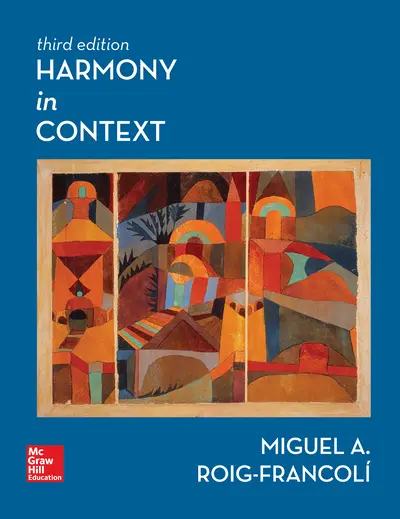My Account Details

ISBN10: 1260055760 | ISBN13: 9781260055764

* The estimated amount of time this product will be on the market is based on a number of factors, including faculty input to instructional design and the prior revision cycle and updates to academic research-which typically results in a revision cycle ranging from every two to four years for this product. Pricing subject to change at any time.
Instructor Information
Quick Actions (Only for Validated Instructor Accounts):
Music Theory Made Relevant
Designed for undergraduate music majors, Harmony in Context provides the richest possible musical context for the study of harmony, constantly encouraging students to translate what they are learning into better performances and better listening. The musical examples and anthology encompass a wide variety of different composers and repertoires. A clear and visually attractive layout, as well as the use of section and subsection headings and lists where appropriate, are essential aspects that contribute to the effective organization of this book. Recordings for all the musical examples from the literature included in both the book and the anthology are available on the book's Online Learning Center.
A Message to the Student: Why Do We Study Music Theory?
Introduction: The Fundamentals of Music
Chapter A Pitch: Notation and Intervals
Chapter B Rhythm and Meter
Chapter C Tonality: Scales and Keys
Chapter D The Rudiments of Harmony I: Triads and Seventh Chords
Chapter E The Rudiments of Harmony II: Labeling Chords. Musical Texture
Chapter F Introduction to Species Counterpoint
Part I: Diatonic Harmony
Chapter 1 Harmonic Progression. The Connection of Chords
Chapter 2 The Fundamental Progression: The Tonic and Dominant Triads in Root Position.
Chapter 3 Harmonic Function; the Subdominant Triad in Root Position
Chapter 4 Triads in First Inversion
Chapter 5 The Supertonic: Melody Harmonization
Chapter 6 Nonchord Tones
Chapter 7 6/4 Chords
Chapter 8 The Dominant Seventh and Its Inversions
Chapter 9 The Leading-Tone Triad
Chapter 10 Cadences
Chapter 11 Building the Context for Harmony I: Phrase Structure
Chapter 12 Building the Context for Harmony II: Thematic Development
Chapter 13 Harmonic Rhythm; Metric Reduction
Chapter 14 The Mediant, Submediant, and Subtonic Triads
Chapter 15 Other Diatonic Seventh Chords
Chapter 16 Harmonic Sequences
Part II: Chromatic Harmony and Form
Chapter 17 Tonicization I
Chapter 18 Tonicization II
Chapter 19 Tonicization III: Secondary Leading-Tone Chords
Chapter 20 Modulation to Closely-Related Keys
Chapter 21 Small Forms: Binary and Ternary; Variation Forms
Chapter 22 Contrapuntal Genres: Invention and Fugue
Chapter 23 Modal Mixture
Chapter 24 The Neapolitan Chord
Chapter 25 Augmented Sixth Chords
Chapter 26 Chromatic Modulatory Techniques:Modulation to Distantly Related Keys I
Chapter 27 Modulation to Distantly-Related Keys II; Linear Chromaticism I
Chapter 28 Introduction to Large Forms
Chapter 29 Expanding Functional Tonality: Extended Tertian Chords; Linear Chromaticism II;
Chapter 30 The German Romantic Lied: Chromatic Harmony in Context
Chapter 31 Toward (and Beyond) the Limits of Functional Tonality
Appendix: Transposing Instruments
Musical Example Index
Subject Index
Accessibility
Creating accessible products is a priority for McGraw Hill. We make accessibility and adhering to WCAG AA guidelines a part of our day-to-day development efforts and product roadmaps.
For more information, visit our accessibility page, or contact us at accessibility@mheducation.com
Need support? We're here to help - Get real-world support and resources every step of the way.